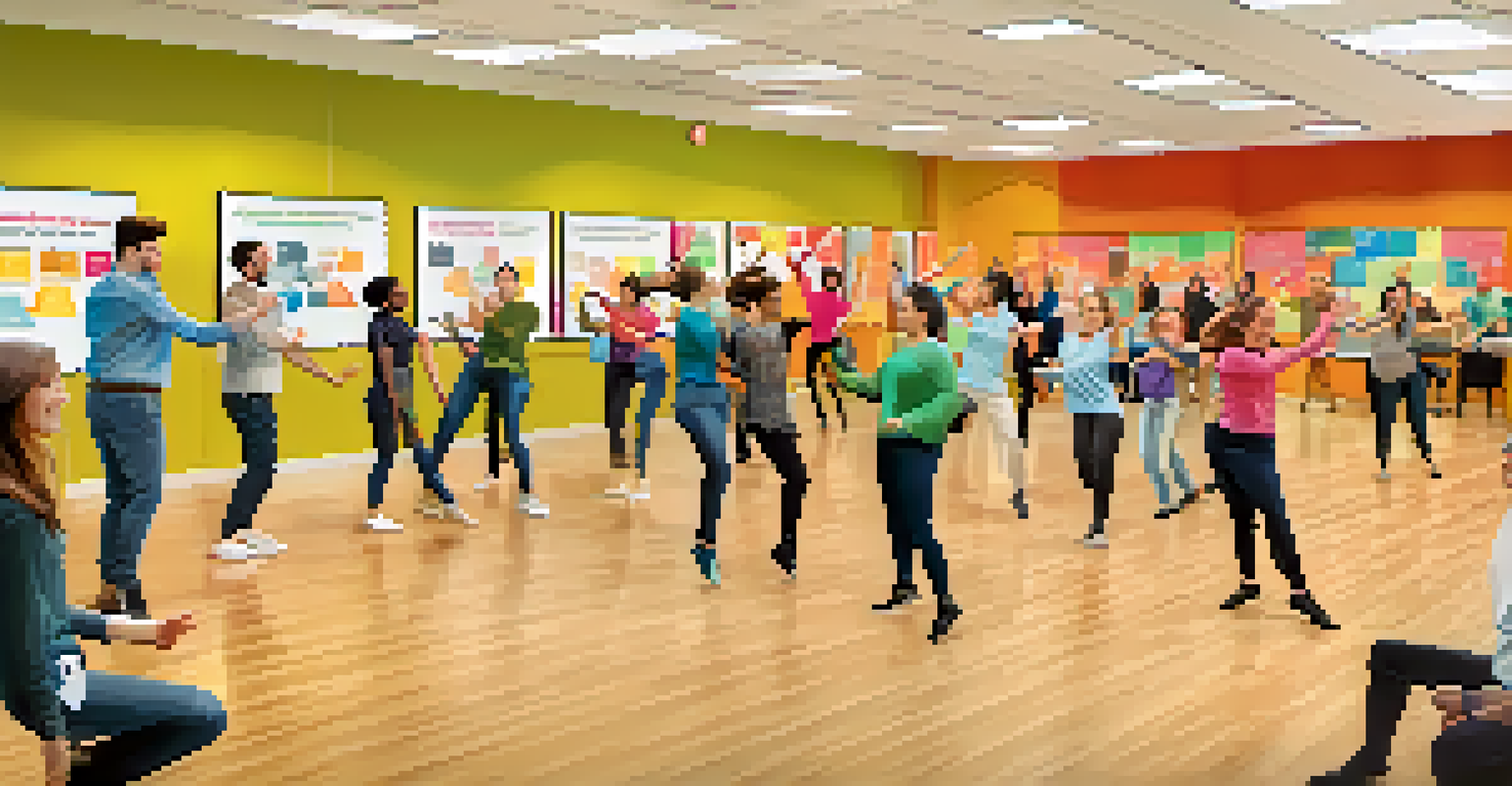Creating a Dance Culture to Foster Positive Work Environment

Understanding the Power of Dance in the Workplace
Dance is more than just movement; it’s a powerful form of expression. In a workplace setting, incorporating dance can break down barriers and foster connections among employees. When people dance together, they share experiences that promote teamwork and creativity.
Dance is the hidden language of the soul.
By embracing dance, organizations can create a unique culture that encourages collaboration and innovation. This doesn’t mean everyone has to be a professional dancer; rather, it’s about the joy and energy that dancing brings to the team. Think of it as a fun way to loosen up and engage with one another.
Moreover, dance can serve as a stress-reliever, helping employees unwind after a long day. It’s a fantastic way to boost morale and make the workplace more enjoyable, ultimately leading to increased productivity and job satisfaction.
Creating Opportunities for Dance in the Workplace
To foster a dance culture, organizations need to create opportunities for employees to engage in dance-related activities. This could be as simple as hosting weekly dance breaks, where employees can gather for a few minutes of movement. Alternatively, consider organizing dance classes or workshops led by professional instructors.

These activities not only promote physical well-being but also strengthen the bonds between team members. When colleagues dance together, they develop trust and friendship, which can translate into better collaboration on work projects. Everyone loves a good dance party, right?
Dance Boosts Team Connection
Incorporating dance in the workplace fosters collaboration and strengthens relationships among employees.
Additionally, consider creating an online platform where employees can share their dance experiences or favorite routines. This can help build a sense of community and encourage participation, even among those who might be hesitant to join in-person activities.
The Role of Leadership in Promoting Dance Culture
For a dance culture to flourish, leadership must actively promote and participate in these initiatives. When leaders embrace dance, it sends a message that the organization values creativity and employee well-being. This visibility can inspire team members to join in and make the most of these opportunities.
Dancing is like dreaming with your feet!
Leaders can set the tone by sharing their own dance experiences or even taking part in dance activities. When employees see their managers getting involved, it helps eliminate any stigma around participating. It’s all about creating a safe space where everyone feels comfortable expressing themselves.
Furthermore, leaders should encourage feedback on dance initiatives to tailor activities to the team’s preferences. This collaborative approach ensures that everyone feels included and valued, making the dance culture even stronger.
Building a Diverse Dance Culture
A successful dance culture embraces diversity and inclusivity. It’s essential to recognize that different employees may have varying dance backgrounds or comfort levels. By offering a range of dance styles, from salsa to hip-hop, you can cater to a broader audience.
Encouraging employees to share their cultural dances can be a fantastic way to celebrate diversity within the organization. It allows team members to learn from each other and appreciate different traditions, creating a richer workplace environment. After all, dance is a universal language that transcends boundaries.
Leadership Drives Dance Culture
Active participation and support from leadership can inspire employees to engage in dance initiatives.
Additionally, consider hosting events that showcase these diverse dance styles, allowing employees to perform if they wish. This not only builds confidence but also fosters pride in one’s heritage, contributing to a more cohesive and supportive work culture.
Integrating Dance into Team-Building Activities
Incorporating dance into team-building exercises can elevate the experience to a whole new level. Instead of traditional trust falls or ropes courses, consider dance-based activities that require collaboration and communication. Activities like choreographed group dances can be a fun way for teams to bond.
These dance-based exercises encourage creativity and problem-solving, as team members work together to create routines. They also promote physical activity, which can lead to increased energy levels and focus. Picture your team laughing and moving together; it’s a recipe for lasting memories.
Moreover, dance can serve as a metaphor for teamwork. Just like in a dance routine, every member plays a crucial role, and synchronization is key to success. This understanding can deepen workplace relationships and improve overall team dynamics.
Promoting Dance as a Stress Management Tool
Dance is an excellent way to relieve stress and improve mental health. By promoting dance as a regular activity, organizations can provide employees with a healthy outlet for their emotions. Whether it’s a quick dance session during a break or a weekly class, it can work wonders for reducing tension.
Engaging in dance releases endorphins, the body's natural mood lifters. This can lead to a more positive outlook among employees, ultimately enhancing workplace morale. When employees feel good, they are more likely to be productive and engaged in their work.
Dance as a Stress Reliever
Regular dance activities provide a healthy outlet for stress, enhancing overall employee well-being and productivity.
Additionally, incorporating mindfulness elements into dance sessions, like focusing on breath and movement, can further enhance relaxation. This holistic approach ensures that employees not only have fun but also leave feeling rejuvenated and ready to tackle the day.
Evaluating the Impact of Dance Culture on Workplace Dynamics
To understand the effectiveness of a dance culture, organizations should regularly evaluate its impact on workplace dynamics. Conducting surveys or feedback sessions can provide valuable insights into how employees feel about the dance initiatives. This information can guide future activities and ensure they meet employee needs.
By measuring factors like employee engagement, morale, and collaboration, organizations can gauge how well the dance culture is resonating. Look for improvements in communication and camaraderie, as these are key indicators of a thriving workplace environment.

Moreover, sharing success stories and testimonials can inspire others to participate. When employees see the positive effects of dance on their colleagues, they may be more likely to join in. It’s all about creating a ripple effect that enhances the overall workplace atmosphere.